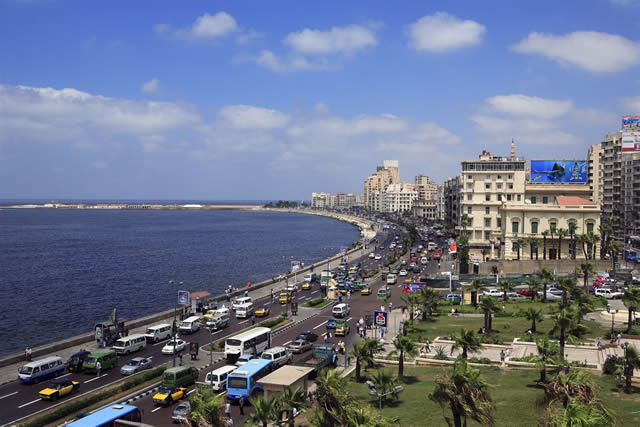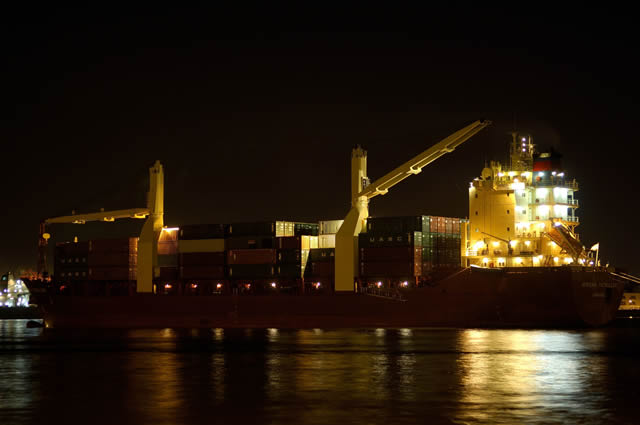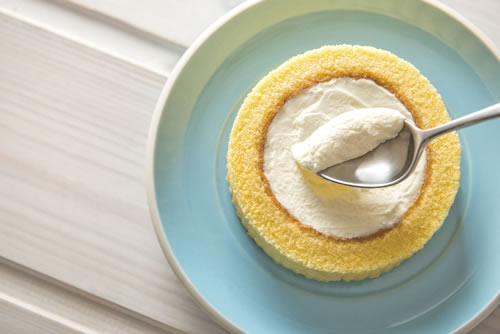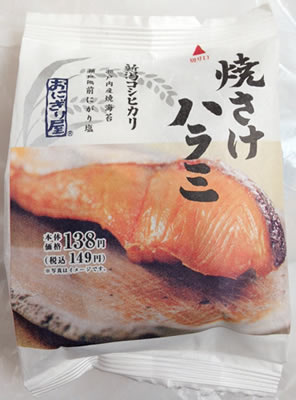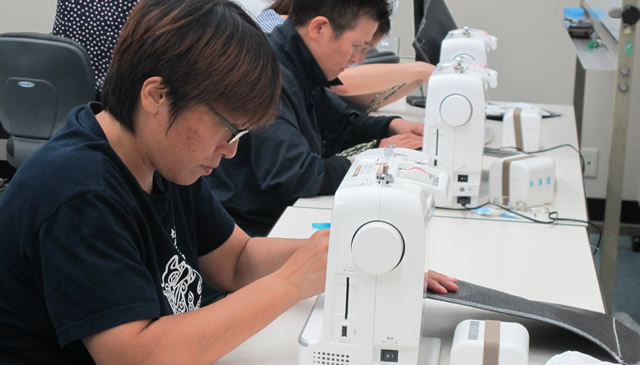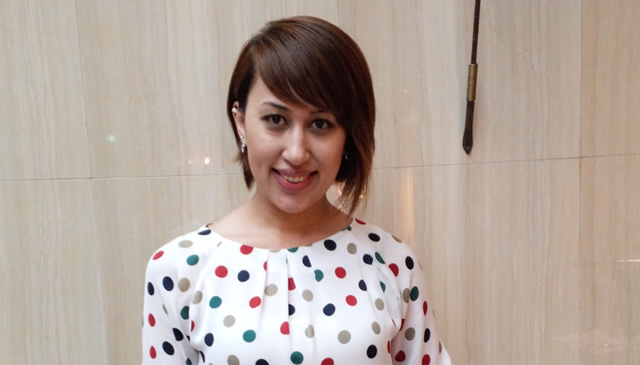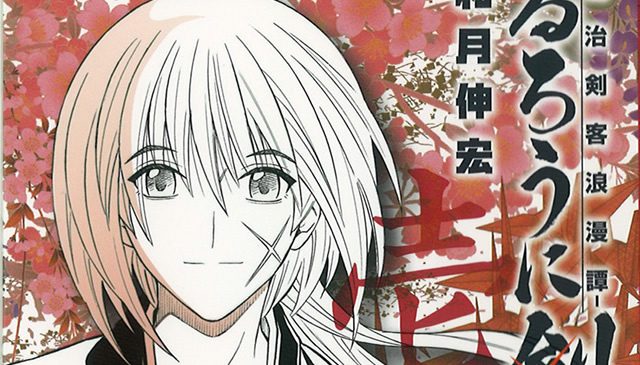-
[From September Issue 2014]
Made out of wood, kokeshi are dolls with round heads and cylindrical torsos. They are said to have originated in the Tohoku region during the Edo era (17 – 19th centuries) as toys made for farmers’ children. They later came to be sold as souvenirs in spa resorts around the country. These days, most people buy them as ornaments.
Founded in 1926, Kijidokoro Satou (Iwaki City, Fukushima Prefecture) is a workshop manufacturing kokeshi. The family of four – SATOU Seikou, a second generation master, his wife Mikiko and their sons Hideyuki and Yusuke – are all kokeshi craftsmen. All four of them won a prize in 2010 at the National Kokeshi Festival Competition, one of the country’s three major kokeshi contests.
Seikou worked as a crew member on a merchant ship until his father Makoto – a kokeshi artisan – passed away. Although he eventually followed in his father’s footsteps, he confesses he had never been taught how to make kokeshi. “My teachers were the tools my father left for me. I learned how to make them (kokeshi) through trial and error and by consulting literature on how to use those tools.
After 20 years of making kokeshi his own way, Seikou started to wish that kokeshi had a more immediate impact. He tried to create something that was not only decorative but also useful in real life. His first attempt was a kokeshi that could act as a receptacle for a stamp. However, it wasn’t particularly popular in the traditional world of kokeshi. “I didn’t make many, so it didn’t cause much of a stir,” he smiles at the recollection.
In the last ten years Kijidokoro Satou’s “useful kokeshi” have begun to attract attention. On becoming a third generation master Seikou’s son Hideyuki created a website that has had a part to play in this. Their range has widened to include kokeshi-shaped stamps and accessories that fit into smartphone ear jacks. Seikou says, “I’m happy with the casual and natural way people use our kokeshi in their daily lives, regardless of the fact that they come from a long tradition.”
Seikou says that the interesting side of kokeshi is that he can end up making something that surprises himself. Nowadays he makes most of his traditional kokeshi to order. They take shape as a result of consultations with customers. “Rather than being something I create, it feels as if they come into being themselves. When I was young, I would try to create what I had in mind, but now I let my brush do its work without thinking much about the result. “Kokeshi may appear expressionless, but upon closer inspection, you see that each one has a different look and is brimming with personality.
What Seikou is now pouring his passion into is making extra small (about 4.5 centimeter tall) traditional kokeshi. He began making them because bigger kokeshi took up so much space. However, it’s harder to make the small ones balance and they require more attention to detail. “It’s that difficulty that’s exciting for a creator.” Even so Seikou, now 67, says, “I enjoy my work, though it’s begun to take a physical toll on me, there are still many other types of kokeshi I want to create.”
Kijidokoro Satou
Text: ICHIMURA Masayo[2014年9月号掲載記事]こけしは丸い頭と円柱状の胴体を持つ木で作られた人形です。江戸時代(17~19世紀)に東北地方で農家の子どもたちのおもちゃとして作られたのが始まりだといわれています。その後、全国の温泉地でお土産として売られるようになりました。近年では観賞用に購入する人がほとんどです。
1926年創業の木地処さとう(福島県いわき市)は伝統こけしを作る工房です。2代目の佐藤誠孝さんと妻の美喜子さん、そして息子の英之さんと裕介さんの家族4人全員がこけし職人です。2010年にはこけし3大コンクールのひとつである全国こけし祭りコンクールで家族みんなが入賞しました。
誠孝さんは、こけしを作っていた父の誠さんが亡くなるまで商船の乗組員として働いていました。その後自然に跡を継ぐ流れになりましたが、実はこけしの作り方を教わったことは一度もありませんでした。「父の遺してくれた道具が師匠みたいなものです。それをどうやって使うのか文献を当たったりして試行錯誤しながら作り方を学んでいきました」。
そうして自分なりにこけしを作るようになって20年目、誠孝さんはこけしをもっと身近に感じてもらいたいと考えるようになります。飾るだけでなく生活の中で使ってもらえるものを作ろうとしたのです。最初に作ったのは印鑑を入れることのできるこけしでした。しかし、伝統こけしの世界ではあまり評判はよくありませんでした。「数も多くは作っていなかったので、そもそも反応がなかったですね」と思い返して笑います。
木地処さとうの「使えるこけし」に注目が集まってきたのはここ10年ほどのことです。息子の英之さんが3代目となりホームページを開設したことも影響しました。今ではこけしの形をした印鑑やスマートフォンのイヤホンジャックに差し込むアクセサリーなど種類も増えています。誠孝さんは「日常生活の中でなんとなく使っているものが、気が付いたら伝統的なものだったという自然な形でこけしを使ってもらえることがうれしいです」と言います。
誠孝さんはこけしの面白さを、自分でも思いがけないものができ上がるところだと言います。現在、伝統こけしは注文を受けてから作ることがほとんどで、お客との打ち合わせを経てでき上がっていきます。「自分が作るというのではなく、作らされているという感じです。若い頃は自分が作りたいものを作ろうとしていましたが、今はどんなものができるのか特に考えることなく筆の流れるままに作業しています」。一見無表情に見えるこけしですが、よく見ると一体一体表情が異なり、個性豊かであることがわかります。
誠孝さんが今一番熱心に取り組んでいるのは一寸五分(約4.5センチ)の極小伝統こけし作りです。大きいこけしだと場所を取るので小さくしてみようと作り始めました。しかし小さいものはバランスを取るのが難しく、集中力も必要です。「その作りづらいところが作り手冥利に尽きるんです」と現在67歳の誠孝さんは話します。「楽しいけれど肉体的にはきつくなってきました、でも、作ってみたいこけしはまだまだあります」。
木地処さとう
文:市村雅代 -
[2014年9月号掲載記事]
Hisham EL-ZIMAITY,
Egyptian Ambassador to Japan
“I once asked someone why the Egyptian vegetable tussa jute or molokhia is so popular in Japan. She answered, ‘because Tussa jute contains umami, a taste Japanese are fond of.’ Egypt is a distant country from Japan, but there are some things we have in common,” smiles the ambassador Hisham EL-ZIMAITY.
The ambassador came to Japan in September 2011. “I soon got used to life in Japan,” he recalls. “I like to try out foods from different countries. Japanese dishes are all delicious. My big favorites are teppan-yaki (cuisine fried on a hotplate) and sushi. Kobe beef is also great,” he says. “The Japanese language is hard, though. I don’t have enough time for study, so unfortunately I still can’t speak it.”
The ambassador has visited many places in Japan including Nara, Kyoto, Osaka and Fukushima. “Wherever I go, I’m impressed with people’s self-discipline. In addition, Japanese people are capable of acting as a group. Such virtues were apparent at the time of the Great East Japan Earthquake and when the stadium (stands) were cleaned up by Japanese supporters after the World Cup soccer matches. I think Egyptians could learn something from this,” he says.
The ambassador has also been to Hiroshima and Nagasaki. “Those atomic bomb tragedies should never happen again,” he says with a sad face. “In Egypt, our Foreign Minister releases a statement every August 6 saying that it’s important never to use nuclear weapons again. We’d like to work alongside Japan in order to abolish nuclear, biological and chemical weapons,” he says.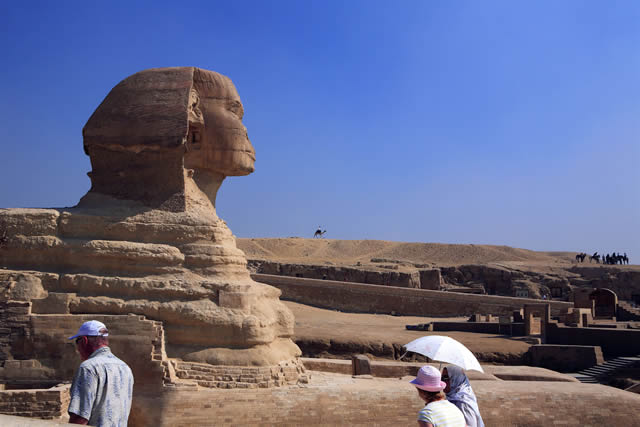
The sphinx
“I also like the honest hardworking spirit of the Japanese,” says the ambassador. “And Japanese people don’t hesitate to venture out into the world to learn about other cultures. Japanese are among the world’s best violinists and pianists in classical music. This is also impressive.”
“Japanese and Egyptians have some things in common,” says the ambassador. “For example, we all cherish family values. I’ve heard that Japanese children often don’t leave their parents’ home until they are married. It’s the same in Egypt. When I go out to restaurants on weekends, I see young people who come to enjoy their time with their parents. I’ve also witnessed situations in which everyone listens respectfully once an older person starts talking. I think it’s just like that in Egypt.”
According to the ambassador, good hygiene is another thing Japanese and Egyptians have in common. “Cleanness is important for Muslims, so we wash before prayers five times a day. I’m under the impression that it’s important also for the Japanese.” He says they’re also alike in the way they incorporate different cultures into their own. “In Japan, people wear all kinds of fashions. Some, however, try to preserve traditions by wearing kimono.”
“In Egypt, more people wear Western clothes in urban areas, but in the countryside, people still dress traditionally,” says the ambassador. “People wear a garment called the jellabiya in the Nile Delta. On the Sinai Peninsula, their outfits resemble those worn by the Jordanian and Palestinian Bedouins. Western Egypt has a Libyan-influenced brownish costume. And in the very hot region of Nubia they wear white. I enjoy wearing something similar to the jellabiya on ceremonial occasions and suchlike.”
The sea front at Alexandria
With its numerous ancient sites, tourists flock to Egypt from all over the world. “Our country had the oldest kingdom in history,” says the ambassador. “Right now, the Great Egyptian Museum is being built near the Giza pyramids with help from Japan. When it’s completed, it’ll be a wonderful place where you can admire the long history of Egypt from the times of pharaohs, to Roman times, to Christian times, through to the Islamic era, finishing off with a panoramic view of the pyramids.”
An issue for the tourism industry of Egypt is that (the country) has so many superb ancient sites that few people visit other tourist spots. “You can go diving in the Red Sea. You can enjoy fishing and all kinds of seafood dishes on the Mediterranean coast. Siwa, an oasis town in the middle of the desert, is believed to be the place where in the Temple of the oracle, Alexander the Great received the order from the god Ammun to rule Egypt and the rest of the world; and Queen Cleopatra enjoyed her baths. Also famous is the Ecolodge hotel, where you can experience the ancient lifestyle.”
“Tourists spend a week in Egypt on average,” says the ambassador. It takes two days just to see the Valley of the Kings and other sites near Luxor, so we are now trying to come up with a strategy to encourage visitors to repeat their visits. We’d like them to visit ancient sites on their first trip and enjoy leisure activities and see Egyptian lifestyles on their subsequent trips.”
In Egypt, you can sample dishes that were eaten in the times of pharaohs. “Onion, carrot, lentil beans, cabbage … these ancient vegetables are painted onto temple walls,” says the ambassador. “One of the common main dishes is Coshari – rice mixed with fried onion and macaroni. My suggestion would be kofta – ground meat grilled on metal skewers. The fava-bean paste we eat on Ramadan nights makes us full. I’d also recommend our dates.”
The Suez Canal
Besides tourism, one of Egypt’s main industries is the manufacturing of aluminum and cement products. Egyptian cotton is also well-known. “The tolls for the Suez Canal are important for Egypt. The bridge – which looks like “rainbow bridge” – Japan built in 2001 over the Suez Canal is helping us. Japan is also cooperating in the construction of a subway line.”
The ambassador enjoys listening to music in his spare time. “I listen to a lot of rock, jazz and soul music. I often go to the jazz club called the Blue Note,” says the ambassador. “I also like reading. I’m now reading about Japanese history and trying to understand why the Meiji Restoration was achieved without much violence. I feel I understand today’s Japan better by learning its history.”
“Egypt has been politically unstable for the past few years, but things have now returned to normal. Please choose Egypt as the destination of your next vacation,” concludes the ambassador. “We are looking forward to welcoming Japanese visitors along with people from around the world.”- Tourism of Egypt
- Photos courtesy of the Embassy of Egypt Tourism Office
Text: SAZAKI Ryo
[2014年9月号掲載記事]ヒシャム・エルゼメイティー
エジプト駐日大使
「エジプトの野菜モロヘイヤはなぜ日本でとても人気なのか、と人に聞いたことがあります。その人は『モロヘイヤにはうまみという日本人の好きな味が含まれているからです』と答えました。日本にとってエジプトはとても遠い国ですが、シェアできるものもあるのです」と、ヒシャム・エルゼメイティー大使はほほえみます。
大使は2011年9月に来日しました。「日本での生活にはすぐ慣れました」と振り返ります。「私はいろいろな国の食べ物を試すことが好きです。和食はどれもおいしいですね。特に好きなのは鉄板焼きと寿司で、神戸ビーフもすばらしい」と言います。「ただし、日本語は難しいです。習う時間もないので残念ながらまだ話せません」。
大使は奈良、京都、大阪、福島などいろいろなところへ行きました。「どこへ行っても人々の規律正しさに感心します。それに日本人は団体行動ができます。東日本大震災のときや、サッカーワールドカップの試合後にスタジアムの清掃をする姿に、そういう長所が現れていますね。エジプト人も学ぶべきだと思います」と言います。
大使は広島と長崎にも行きました。「原子爆弾による悲劇は二度と起きてはならないことです」と悲しい顔をします。「エジプトでは外務大臣が毎年8月6日に、核兵器を二度と使用しないことが重要という談話を発表します。日本と共に、核兵器や生物兵器、化学兵器をなくす活動をしていきたいと思います」と語ります。
大使は「日本人が真面目によく働くところも好きです」と言います。「それに日本人は他の文化を知ろうとして積極的に世界へ出ます。クラシック音楽のすぐれたバイオリニストやピアニストに日本人がいたりするでしょう。そういうところもいいですね」。「日本人とエジプト人には共通する点があります」と大使。「例えば家族を大切にすることです。日本の家庭では、子どもは結婚するまで家を出て行かないことが多いと聞きます。これはエジプトと同じです。また、週末にレストランへ行くと、若い人が親と来て一緒に食事をしているのを見かけます。年長者が話し始めると皆が敬意をもって聞く姿も見られますね。エジプトと似ていると思います」。
大使によれば、清潔さも日本人とエジプト人の共通点です。「ムスリムにとって清潔であることは重要で、1日5回手を洗います。日本人も清潔さを重視していると感じます」。多様な文化をとり入れるところも似ていると言います。「日本にはいろいろなファッションの人がいるでしょう。でも着物も着る人もいて伝統を守る努力をしていますね」。
「エジプトでも都市部では洋服を着る人が多いですが、地方では伝統的な衣服を着ています」と大使。「ナイル・デルタではガラベーヤというワンピースの服を着ます。シナイ半島ではヨルダンやパレスチナのベドウィンに近い衣服です。エジプト西部では茶色がかったリビアの影響を受けた服。そして南部のヌビアはとても暑い地域なので、白い服がよく着られます。私自身はお祝い事のときなどにガラベーヤに似たものを着ますよ」。
エジプトは古代の遺跡が多く残っていて、観光客が世界中から集まる国です。「わが国は最も早く王国ができた国です」と言います。「今、日本の援助によって大エジプト美術館がギザのピラミッド近くに建設されています。完成したらエジプトの長い歴史を、ファラオの時代、ローマの時代、キリスト教の時代、イスラムの時代と順に見て行き、最後にピラミッドのパノラマを見ることができる、すばらしい施設になりますよ」。エジプトの観光業の課題は、古代のすばらしい遺跡が多すぎるので、その他の観光地になかなかお客が来てくれないことです。「紅海ではダイビングができます。地中海沿岸では釣りやさまざまな魚料理が楽しめます。シーワという砂漠の中のオアシスの町は、アレクサンダー大王がアメン神からエジプトおよび世界の支配を託されたオラクル神殿、またクレオパトラ女王が入浴を楽しんだ場所だといわれています。昔のままの生活を体験できるエコロッジというホテルも有名です」。
「観光客がエジプトで過ごす平均的な日数は1週間です」と言います。ルクソール辺りの王家の谷などを見るだけで2日かかってしまいますから、今私たちは、リピーターを増やす計画を練っています。1度目は古代遺跡を旅してもらい、2度目以降はレジャーを楽しんだりエジプト人の生活にふれたりしてもらおうと思います」。
エジプトでは、ファラオの時代に食べられていたものを食べることができます。「タマネギ、ニンニク、レント豆、キャベツ、これらは神殿の壁画にも描かれている昔からの野菜です」と大使は話します。「メインディッシュで一般的なのはコシャリという、米に揚げタマネギやマカロニなどを混ぜた食べ物です。私のお勧めはコフタという、ミンチを金串につけて焼いた肉です。ラマダン(断食)月の夜に食べるフール豆のペーストは腹持ちがいいですし、ナツメヤシもお勧めですよ」。
エジプトの主産業は観光業の他、アルミ製品などの重工業です。エジプト綿もよく知られています。「スエズ運河の通行料はエジプトにとって大きな柱です。スエズ運河は日本が2001年にレインボーブリッジに似た橋を建ててくれたので助かっています。地下鉄の建設にも、日本が協力してくれているのですよ」。大使は余暇に音楽を聞くことを楽しんでいます。「ロックやジャズ、ソウルミュージックをよく聞きます。ブルーノートというジャズクラブにも行きますよ」と大使。「読書も好きです。今は日本の歴史について読んでいて、なぜ明治維新がそれほど暴力的ではないやり方でできたのかを理解しようとしています。歴史を知って、今の日本がより理解できた気がします」。
「この2~3年、エジプトの政情は不安定でしたが、現在は落ち着きつつあります。ぜひエジプトを、次の休暇に訪れる場所に選んでください」と大使は最後に言いました。「私たちは日本人を、そして世界の人を喜んでお待ちしています」。- エジプト大使館観光局
- 写真提供:エジプト大使館観光局
文:砂崎良
-
[From September Issue 2014]
This ruined castle sits at the summit of a mountain 353.7 meters above sea level. A stone wall made at the end of the 16th century runs north to south for 400 meters and east to west for 100 meters. On fine days from autumn to winter a morning mist makes it look as if the castle is floating in the clouds. It is also known as the “The Heavenly Castle” and “Japan’s Machu Picchu.” Because the road that leads to the castle site is steep and the site of castle is not paved, visitors are advised to go wearing sports shoes. The site is often used as a film location.
Transportation: 20 minutes on the Tenku bus from JR Takeda Station to Chufuku Chushajyo (parking lot halfway up the mountain). Approximately 20-minute walk from the parking lot.
Address: 169 Takeda-aza Kojozan, Wadayama-cho, Asago City, Hyogo Prefecture
Admission: Adults (high school age and over) 300 yen, free for children of junior high school age and younger
Admission dates and times:
March 20 – September 20 / 9:00 am – 4:00 pm
September 21 – December 10 / 3:00 am – 4:00 pm
Asago City[2014年9月号掲載記事]標高353.7メートルの山頂にある城跡。16世紀末に造られた石垣が、南北400メートル、東西100メートル続く。秋から冬にかけてよく晴れた早朝には朝霧がかかり、城が雲に浮かんでいるような姿が見られる。「天空の城」「日本のマチュピチュ」とも呼ばれている。城跡への道のりは坂道で、また城跡内も舗装されていないので、運動靴で行くのがおすすめ。ロケ地によく使われる。
交通:JR竹田駅から天空バス乗車約20分で中腹駐車場へ。駐車場から徒歩約20分
所在地:兵庫県朝来市和田山町竹田字古城山169番地
観覧料金:大人(高校生以上)300円、中学生以下無料
観覧期間と時間:
3月20日~9月20日 午前9時~午後4時
9月21日~12月10日 午前3時~午後4時
朝来市 -
[From September Issue 2014]
Founded in 1975, Lawson was the first chain of convenience stores to open branches in every prefecture in Japan. Currently, it has over 10,000 stores nationwide and another 500 stores overseas. Especially popular is the “Uchi Café SWEETS Premium Roll Cake” series, which Lawson started selling in 2009. There are also “Natural Lawson” stores that focus on healthy and environmentally-friendly products.
[No. 1] Pure Roll Cake 152 Yen
This cake features a very fine spongy texture, a subtle sweetness and exceptionally thick and full bodied fresh cream. Only domestic ingredients are used.

[No. 2] Bran Rolls (Two-Piece Set) 116 Yen
Catering to health conscious customers concerned about their sugar intake, these bread rolls are made from wheat bran. Versions are also available with cheese and chocolate fillings.

[No. 3] Rice Ball Shop “Seared Salmon Steak” 138 Yen
As if it were handmade, this rice ball is plump and soft. The taste of the fatty salmon can be enjoyed from the very first bite.

LAWSON[2014年9月号掲載記事]1975年創業。コンビニ業界で初めて日本国内すべての都道府県に出店したコンビニエンスストア。日本全国に1万以上の店舗が、世界に約500店舗がある。2009年から販売する「Uchi Café SWEETSプレミアムロールケーキ」シリーズは特に人気。健康や自然に配慮した「ナチュラルローソン」もある。
【No.1】ピュアロールケーキ 152円
スポンジはきめ細かく、甘さは控えめだがコクと深みのある生クリームが特徴。すべて国産の原材料を使っている。
【No.2】ブランパン2個入 116円
糖質が気になる健康志向のお客の声に応えた、ブラン(ふすま)を使ったパン。チーズやチョコレートが入ったものも。
【No.3】おにぎり屋「焼さけハラミ」138円
手で握ったようなふっくらとした食感。脂ののったうまみたっぷりのサケが一口目から楽しめる。
-
[From September Issue 2014]
Venugopal TENKAYALA
President of Shinko Advisors
“Japanese companies have great technology. In spite of this, when it comes to expanding into India, many people lose their way due to fear of risks and partly due to hesitation. I wanted to lend a helping hand to such companies,” Indian Venugopal TENKAYALA says, explaining why he started his business in Japan.
Tenkayala came to Japan in 2000. “At first, I was thinking of eventually moving on to the United States, but I decided to stay because I liked Japan. I appreciated the safety and cleanliness of things like the water, air, and the excellent infrastructure.” He continued to study, while at the same time gaining business experience in a foreign bank, after which he got permanent residency in Japan.
“I wanted to have a business of my own one day. I gained an MBA in finance in 2010 at McGill University in Canada and that was the impetus for me to begin preparations for starting up a business.” Tenkayala hoped to build on his business experience in Japan. In 2011, he founded Shinko Advisors, a consulting firm, to help Japanese companies expand their businesses into India.
“I recently took about 20 Japanese companies with me on a visit to India, showing them around various cities over the space of four months. In relation to their plans for expansion, I answered their questions on safety, infrastructure, management possibilities and finding local business partners,” he says, explaining part of the work he does. His company now has offices in Chuo Ward, Tokyo Prefecture, as well as in Bangalore in the state of Karnataka, India.
“The strength of Shinko Advisors lies in a good understanding of the business environment in both Japan and India,” says Tenkayala. “Just to give you an example, Japanese companies tend to regard India as a country that has a homogenous culture. In actual fact, India is an immense country in which the culture and laws vary from one region to another. The difference is so great between the north and the south in particular that it’s better to consider them as two countries,” he explains.
Another side to Tenkayala is his teaching career. He’s Vice Chairman and visiting professor at the Shree Institute of Technical Education, a private school in the state of Andhra Pradesh, India. “I’m good at logically breaking down issues that are difficult to understand. When I’m dealing with a client that’s consulting, with students it becomes teaching. For me, consulting and education is practically the same thing. In the future I plan to concentrate my efforts on the business of educating Japanese employees in India.”
“India not only has a large market, but it’s also a country that can be a base from which to sell products to the Middle East and Africa. Although many Japanese companies are sending employees to India these days, there are times when I feel that their international business training is inadequate. I want to train and support such employees, to help Japanese companies launch their business in India more efficiently,” he says.
Shinko Advisors KK
Text: SAZAKI Ryo[2014年9月号掲載記事]株式会社新光アドバイザー代表
ベヌゴパル・テンカヤラさん
「日本の企業はすばらしい技術を持っています。それなのにインドへ進出するとき、リスクを恐れたり、ためらったり、迷ったりしている方が多いんです。そういう会社の手助けをしたいと思いました」とインド出身のベヌゴパル・テンカヤラさんは、日本で起業した理由を語ります。
テンカヤラさんは2000年に来日しました。「最初は、そのうちアメリカへ行こうかなと思っていたんですが、日本が好きになったので住み続けることにしました。水や空気などが安全で清潔なところや、インフラが充実している点が気に入ったんです」。その後外資系銀行でビジネスの経験を積みながら勉強を続け、日本の永住権をとりました。
「いつかは自分のビジネスをやりたいと思っていたんです。2010年、カナダのマギル大学でファイナンスのMBAを取ったことをきっかけに、起業の準備を始めました」。テンカヤラさんは日本でのビジネス経験をいかしたいと思いました。そして2011年、日本企業のインド進出をサポートするコンサルタント会社、株式会社新光アドバイザーを立ち上げました。
「この間は20社ほどの日本企業と一緒にインドを訪れて、4ヵ月間、いろいろな都市を案内しました。治安やインフラはどうか、マネジメントは可能か、現地にパートナーを見つけられるかなどの情報を提供して、プランニングに関わったんです」と仕事の一部を紹介します。会社は、今は東京都中央区とインドのカルナータカ州バンガロールにオフィスを持っています。
「新光アドバイザーの強みは、日本のビジネス事情とインドのビジネス事情の両方をよく知っていることです」とテンカヤラさん。「例えば、日本の企業はインドをひとつの文化圏だと考えがちです。現実には、インドはとても大きい国で地域によって文化や法律が異なります。北と南の違いは特に大きいので、北部と南部は別の国だと考えた方がいいです」と説明します。
テンカヤラさんは教育者の一面も持っています。インドのアンドラ・プラデシュ州にある私立シュリー工科大学の副学長で客員教授です。「私が得意なのは、わからないことを論理的な考え方で解決できることです。そのときの相手が企業ならそれはコンサルティング、学生なら教育になります。だから私にとっては、コンサルティングと教育は同じようなものなんです。今後は日本企業の社員をインドで教育するビジネスにも力を入れるつもりです」。
「インドは市場が大きいだけでなく、中東やアフリカへ物を売る拠点にもなり得る国です。今、多くの日本企業が社員をインドに送り込んでいますが、社員に対する国際ビジネス教育が不充分なのではないかと感じることがあります。私は、そういう社員の方を研修、サポートして、日本企業がより効率的にインド進出できるようお手伝いしたいと思っています」と話します。
株式会社新光アドバイザー
文:砂崎良 -
[From September Issue 2014]
Brother
Sewing machine, typewriter, facsimile, printer and online karaoke system: all of these products make our lives convenient and comfortable. Brother Industries, Ltd., in Nagoya, Aichi Prefecture has produced all of these items. Founded in 1908 as Yasui Sewing Machine Co., the company repaired imported sewing machines.
Before he died, YASUI Kanekichi, the founder of the company, stated in his will to Masayoshi, the eldest son of his ten children, that “you should cooperate with your brothers.” Masayoshi took the opportunity to change the company name to “Yasui Brothers Sewing Machine Co.” and joined forces with his brothers to complete a domestically-made sewing machine. Since then they have used the brand name “Brother.” Brother was later used in their company name, too.
Brother Industries’ defining characteristic is its corporate culture of being up for a challenge and unafraid to fail. For instance, in 1986 the company put the TAKERU, a vending machine for PC software on the market, but in the end the product failed. However, using the technology acquired through developing the machine, an online karaoke system was developed. The system is now known by the name of JOYSOUND and has become one of the top brands in the karaoke business.
Brother Industries has not stuck to one product, but has changed the focus of its business along with the times. For instance, the PRIVIO NEO series was developed using a revolutionary method to create a combination printer-copier-scanner-fax machine that anybody would want to own. Its most unique feature is that to slim down the product, the A4 size printout comes out the front vertically, not horizontally. However, printing vertically made the paper curl. In order to prevent this, the developers put tiny vertical waves in the paper. And that’s how they came up with such an innovative product.
Brother Industries does more than develop original products. The company has used its resources to support victims of the Great East Japan Earthquake in the Tohoku region. For example, company employees started up an initiative to make sandbags – which are indispensable for growing seaweed. At first, volunteers got together and made 200 sandbags using their sewing machines both at work and at home, then sent them to Shichigahama, Miyagi Prefecture.
The response from the fishermen was that they wanted more. So, 150 additional sandbags were sent. This became an annual activity and, in 2013, 850 sandbags were made. This year, 1,000 sandbags are to be sent. The company canteen has been serving up dishes made using the seaweed as an ingredient for a limited period. The business that started out with sewing machines has ended up bringing together staff and the people of Tohoku in a collective effort that has borne fruit.
Brother Industries, Ltd.
Text: ITO Koichi[2014年9月号掲載記事]ブラザー
ミシン、タイプライター、ファクシミリ、プリンター、通信カラオケシステム、どれも私たちの暮らしを便利にしたり、快適にしたりする製品ばかりです。愛知県名古屋市にあるブラザー工業株式会社は、これらの製品をすべて手がけてきました。その出発点は1908年創業の「安井ミシン商会」という輸入ミシンの修理を行う会社
です。
会社を興した安井兼吉さんは、10人兄弟の長男である正義さんに「兄弟で協力するように」と言い残して亡くなりました。これを機に正義さんは社名を「安井ミシン兄弟商会」と改め、兄弟で力を合わせて国産ミシンを完成させました。このときから「ブラザー」という商標を使うようになりました。その後、社名にも使われるようになりました。
ブラザー工業の特徴は、失敗を恐れずに挑戦する社風です。例えば、1986年にパソコンソフトの自動販売機、TAKERUを発売したものの失敗に終わりました。しかし、その開発を通じて培った技術を生かして通信カラオケを開発。このシステムは今日、JOYSOUNDの名でカラオケ業界のトップブランドの一つとして知られるほどに成長しています。
ブラザー工業は一つの商品にこだわらず、時代に合わせて主力事業を変えてきました。例えば複合機、PRIVIO NEOシリーズは、従来とはまったく異なる方法で、誰もが欲しくなる複合機を目指して開発。最大の特徴は、奥行を短くするために、印刷されたA4サイズの紙を手前に、縦向きでなく横向きに取り出せるようにしたことです。けれど、横向きだと紙がカールします。そこで、開発者は紙に小さな縦波をつける工夫でこれを防止。これまでの常識を覆す製品を完成しました。
活動は独自製品を開発することばかりではありません。東日本大震災で被災した東北の支援にも力を入れています。その一例として、従業員の呼びかけで、ワカメの養殖になくてはならない道具、サンドバッグをつくっています。まず、2012年に有志が集まって会社や自宅のミシンで200枚のサンドバッグをつくり、宮城県七ヶ浜町に送りました。
すると、漁師の人達からもっとほしいという声が寄せられました。そこで、追加で150枚を送りました。この活動は毎年恒例となり、2013年は850枚を製作。今年は1,000枚を送る予定です。収穫されたワカメは社員食堂の料理の食材として期間限定で提供されます。出発点のミシンによって、従業員と東北の人たちの思いが実を結んだ社会貢献といえるでしょう。
ブラザー工業株式会社
文:伊藤公一 -
たくさん話ができるこの仕事が好き
- Hiragana Times
- Mar 11, 2015
[From September Issue 2014]
Rukshona ESHPULATOVA
“When I can explain in beautiful and courteous Japanese, customers are pleased and say, ‘I’ll buy another one,’ or ‘Please help me next time, too.’ That makes me glad and gives me a sense of purpose; the more customers I’m put in charge of, the more my salary increases,” says Rukshona ESHPULATOVA. Rukhshona came to Japan in April 2013, and joined Somo Japan Inc. this January. She is in the car exporting business.
Rukhshona is from Uzbekistan, a country in Central Asia. When she was a child, she encountered Japanese tourists and became interested in Japan. Then she learned the Japanese language from Japanese teachers at the Samarkand College of Tourism. “There are a lot of tourist attractions in Samarkand. I took the teachers there and guided them in Japanese,” Rukhshona says, reflecting back.
However, she later enrolled at the Samarkand State Institute of Foreign Languages, which in those days did not have a Japanese studies department. Rukhshona studied in the English department and became a tour guide after graduating. “Because my major was English, I could not obtain the necessary qualification to become a Japanese-speaking guide. Before long I had forgotten Japanese,” she says regretfully.
Rukhshona thought of going to Japan to study the language once again. Her older brother who lived in the United States helped her out financially. “I watched online videos of the classes provided at the various language schools in Japan. Out of them, I thought that the Academy of Language Arts in Shinjuku Ward, Tokyo, was a good fit for me. Most importantly, the teachers are friendly and cheerful. In addition, they let the students speak a lot while incorporating information useful in everyday life. I thought that their teaching methods were good,” says Rukhshona.
Because prices in Japan are high, she had to start working part time as soon as she arrived. On weekdays, she would go to school from 9:30 am to 1:30 pm and then work afterwards at a restaurant until 11:00 pm. “Because I also worked on Saturdays and Sundays, I was very busy and it was tough. So I used to review the expressions that I learned during class at work the same day. In order to learn the words I did not know, I asked ‘kore wa nan desuka’ (what is this?) to my fellow part-timers,” Rukhshona laughs.
Rukhshona was brought up in an environment where Tajik, Uzbek, and Russian were used. “Because I studied Japanese and English after I grew up, I use Uzbek as a reference when I speak Japanese since the word order is similar. English is close to Russian, so I use Russian as reference when speaking in English,” says Rukhshona. “Also, when I used to do guide tours in English, I learned to check if I was speaking well by observing the reactions of the person I was addressing, as well as ways to control my uneasiness when speaking in a foreign language. This experience has now come in handy with my Japanese study.”
Currently, Rukhshona uses Japanese, English, and Russian for work. “I often explain things in Russian to customers as I read Japanese documents. English words written in katakana like ‘support’ and ‘inner panel’ were very difficult. However, as with difficult kanji, if I use it for work, I can remember it. Also, since I like talking, I love this job because I can talk to customers. I am very happy because I have a job that I love doing,” she smiles.Text: SAZAKI Ryo[2014年9月号掲載記事]
エシプラトワ・ルクショナさん
「きれいで丁寧な日本語で説明ができると、お客様が喜んで『もう一台買うよ』とか『次回もよろしく』と言ってくださいます。私も嬉しいし、やりがいを感じますし、担当するお客様が増えるとお給料も増えます」とエシプラトワ・ルクショナさんは話します。ルクショナさんは2013年4月に来日し、今年1月にソモジャパン株式会社に入社しました。車を輸出する仕事をしています。
ルクショナさんは中央アジアの国ウズベキスタンの出身です。子どものとき、日本人観光客に会って日本に興味をもちました。そしてサマルカンド観光サービス専門学校で、日本人教師から日本語を学びました。「サマルカンドには観光名所がたくさんあります。先生方を連れていって日本語でガイドしましたよ」とルクショナさんは振り返ります。
しかし進学したサマルカンド国立外国語大学には当時、日本語学科がありませんでした。ルクショナさんは英語学科で学び、卒業後は観光ガイドになりました。「専攻が英語だったので、日本語を使うガイドの資格はとれなかったんです。そのうちに日本語を忘れてしまいました」と残念そうに話します。
ルクショナさんは、日本へ行って日本語をもう一度勉強しようと考えました。アメリカに住んでいるお兄さんが経済的に援助してくれました。「ネットの動画で日本のいろいろな語学学校の授業を見たんです。その中で東京、新宿区のアカデミー・オブ・ランゲージ・アーツがいいなと思いました。まず、先生たちがフレンドリーで明るいんです。それに、生活に役立つ情報を盛り込みながら生徒にたくさん発言させます。教え方が上手だと思いました」とルクショナさん。
日本の物価が高いので、来日してすぐにアルバイトを始めなければなりませんでした。平日は午前9時半から午後1時半まで学校へ行き、その後11時までレストランで働きました。「土日もバイトでしたから、忙しくて大変でした。だから、授業で習った表現をその日のうちにバイト先で使って復習したんです。知らない単語は『これは何ですか』とバイト仲間に聞いて覚えました」とルクショナさんは笑います。
ルクショナさんはタジク語、ウズベク語、ロシア語を使う環境で育ちました。「日本語と英語は大きくなってから勉強しましたから、日本語を話すときは、語順の似ているウズベク語を参考にしています。英語はロシア語に近いので、ロシア語を参考にして話します」とルクショナさん。「それに英語で観光ガイドをしていたとき、相手の反応を見てうまく話せているかチェックしたり、外国語で話す不安を抑えたりするやり方を身につけました。この経験が今、日本語学習に役立っています」。
現在、ルクショナさんは日本語、英語、ロシア語を使って働いています。「日本語の資料を見て、お客様にロシア語で説明することが多いです。『サポート』や『インナーパネル』など、英語のカタカナ書きには苦労しました。でも難しい漢字も仕事で使えば覚えます。それに私は話すことが好きなので、お客様と話ができるこの仕事が好きです。好きな仕事ができる今がとても幸せです」とほほえみます。文:砂崎良
-
[From September Issue 2014]
Rurouni Kenshin (Wandering Swordsman Kenshin):
A Romantic Tale of a Meiji Swordsman
Set in the closing days of the Edo period (19th century), the main character is HIMURA Kenshin, a master swordsman widely feared as Hitokiri Battosai (Battosai the Killer Swordsman). The tale is set in a dramatic period when the governing Shogunate is overthrown by force and political machinations, bringing about a dramatic change from the Edo period to the Meiji period (the 19th to 20th centuries). This series was published in Weekly Shonen Jump between 1994 and 1999, and it was also adapted into a variety of media, including movies and novels. It’s popular both in Japan and overseas.
“Rurouni” is a coined word that means “aimless wanderer.” Having carried out assassinations as an anti-Shogunate swordsman, Kenshin is forced to quit because of an unfortunate incident. When the Meiji period arrives, he vows to never kill again, instead becoming a wanderer who travels around the country.
One day, Kenshin saved a girl named KAMIYA Kaoru in downtown Tokyo. Kaoru has inherited the dojo of Kamiya Kasshin School from her father, however, it is just about to fail financially. Kenshin and Kaoru develop feelings for each other. Now living in Kaoru’s home, he becomes good friends with MYOJIN Yahiko and SAGARA Sanosuke, spending his days peacefully in their company.
However, his past as a killer relentlessly comes back to haunt him. Because of an incident, Kenshin’s ability becomes known to the authorities, and he began to receive requests to escort military officials. Eventually he is challenged to a duel by UDO Jin-e, a man obsessed with perfecting his deadly swordsmanship. Though Kenshin wins this duel to the death, Jin-e tells him with his dying breath that Kenshin is a killer at heart.
After some heavy fighting, Kenshin discovers that his instinct as a killer swordsman is reawakening. While fearing that he might lose sight of himself, he resolves to do battle against SHISHIO Makoto, who is plotting to wage war against the Meiji government.
Just when it seems as if Kenshin has conquered his fear of losing control of himself and going on a killing rampage – that he has finally freed himself from the past – a man named YUKISHIRO Enishi appears. Enishi is the younger brother of Kenshin’s deceased wife, Tomoe. Enishi saw Kenshin kill his sister in the confusion of battle. Determined to take his revenge Enishi kidnaps Kaoru. Kenshin must once again come face to face with his greatest sin – of having lost his lover by his own hand.
Set at the historic turning point from the Edo period to the Meiji period, the tale introduces characters that really existed and events that really happened at that time, giving the drama a realistic appeal. The characters in the tale, while being thrust into the upheaval of the times, struggle to live life to the fullest according to their own principles.
Text: HATTA Emiko[2014年9月号掲載記事]るろうに剣心-明治剣客浪漫譚-
江戸時代末期(19世紀)に人斬り抜刀斎として恐れられた剣の達人、緋村剣心が主人公。幕府という政治体制が、武力行使と政治工作によって倒され、江戸から明治(19~20世紀)へと劇的に変化した時代を背景にしています。1994~1999年まで週刊少年ジャンプにて連載され、映画や小説などさまざまな方面でメディア化されました。国内外を問わず人気の高い作品です。
「るろうに」とは、流れ者を意味する造語です。討幕派の志士として暗殺を実行していた剣心は、ある不幸な事件をきっかけに影の任務を退きます。明治になってからは「不殺」の誓いを立て、流浪人として全国を旅します。
ある日、東京の下町で神谷薫という少女を助けます。薫は神谷活心流の道場を父から受け継いでいましたが、道場を奪われそうになっていました。二人はいつしか心を通い合わせるようになります。薫の家に居候することになった剣心は、明神弥彦や相楽左之助と親しくなり、穏やかな日々を過ごします。
しかし人斬りだった過去は容赦なく追いかけてきます。ある事件で剣心の実力を知った警察から、陸軍の役人を護衛する依頼が舞い込みます。そして人斬りへの強烈な欲望を持つ鵜堂刃衛に戦いを挑まれます。死闘の末に勝利しますが、刃衛は剣心の中にも人斬りの本性が巣食っていると言い残します。
厳しい戦いをいくつも経て、封じていた人斬りの本能が目覚めていきます。自らを見失う恐れを抱えたまま、明治政府に戦争を仕掛けようと企む志々雄真実との戦いを決意します。
人斬りとして暴走する恐怖を克服し、過去に区切りをつけたかに見えたとき、雪城縁が現れます。縁は剣心の妻だった巴の弟で、戦いの巻き添えで剣心に殺される姉を目撃していました。縁は復讐するために薫を誘拐します。ついに剣心は最大の罪――愛する人を自分のせいで失った過ち――と再び向き合います。
本作は江戸から明治という歴史の転換期を舞台に、実在する人物や事件を物語に盛り込むことでリアリティーが演出され、魅力を増しています。登場人物たちは、激動する時代に振り回されときに踏みにじられながらも、各々の立場で懸命に生きています。
文:服田恵美子 -
[From August Issue 2014]
Due to the declining population, many schools in Japan have been merged or closed. In 2008, Yoshimoto Kogyo, a company known for its comedy shows, moved its Tokyo head office to abandoned school buildings in Shinjuku Ward, Tokyo. Some of its original classroom desks and chairs are still being used. Thus, there are many ways to repurpose abandoned school buildings.
Arts Chiyoda 3331 (Chiyoda Ward, Tokyo) has turned a former junior high school building into an arts center. With its galleries and café, the site is a focal point for cultural activities, including exhibitions and lectures. At lunch it’s bustling with people who work nearby and mothers pushing baby carriages. In the evening you can find children doing their homework there.
“Visitors appreciate events like bazaars and music festivals that are held in spaces which were formally a gymnasium and rooftop. There’s an organic garden on the rooftop. One of our defining features is that anyone, not just people interested in art, can easily use it (the center),” says TAMAOKI Makoto, head of public relations. There are plans to periodically invite foreign artists there in the future.
Sarusho
In the town of Minakami, Gunma Prefecture, the buildings of Sarugakyo Elementary School – abandoned in 2008 – were given a new lease of life in 2012 as a hostel called “Elementary School for Lodgers, Sarusho.” Surrounded by lush nature, guests are free to use the swimming pool, the playground and the kitchen. Among the lodgers are students attending sport camps, working adults attending company training sessions and many others there purely for leisure pursuits.
“Other abandoned school buildings are often remodeled for use as ryokan or minshuku (traditional Japanese-style lodging). At Sarusho, we wanted to repurpose them as accommodation, but to leave the school buildings as they were. It was hard to get the fire brigade, the Bureau of Public Works and the public health center to understand this idea,” says IIJIMA Kenji, the “principal” of Sarusho. He’s attempting to run the place with his own funds, without receiving any subsidies from local government.
ITO Masaaki, who has used Sarusho’s facilities with a small group, says, laughing, “We enjoyed playing fondly remembered games such as tag, long rope jumping, catch, and truth or dare. It was a novelty to drink alcohol in a classroom and run along the corridors.” An additional charm of this facility is the fact that you can make as much noise as you want, since it’s rented to just one group per day.
Depending on your creativity, there is no limit to the ways abandoned school buildings can be reused. They’ve been used as hospitals, libraries, welfare facilities and locations for film shoots. School buildings are solidly built. While it’s costly to demolish them, they can regenerate areas and create jobs when effectively repurposed.Text: TSUCHIYA Emi[2014年8月号掲載記事]
日本では、人口の減少とともにたくさんの学校が統合されたり閉校・廃校になったりしています。お笑いで知られる吉本興業は2008年に東京本部を移しましたが、その先は東京都新宿区にある廃校でした。教室の机や椅子の一部はそのまま使われています。このように廃校はさまざまな形で再活用されています。
アーツ千代田 3331 (東京都千代田区)は中学校だった建物を利用したアートセンターです。ギャラリーやカフェなどがあり、展覧会や講演会といった文化的活動の拠点として利用されています。お昼時には近くに勤める人たちやベビーカーを押す母親たちで賑わいます。夕方にはここで宿題をする子どもたちの姿も見られます。
「体育館や屋上空間をバザーや音楽祭の会場として活用したイベントなどは来館者に好評でした。屋上にはオーガニック菜園もあります。アートに興味のある人だけでなく、誰でも気軽に利用できるのが特徴です」と、広報担当の玉置真さんは言います。今後も海外のアーティストを定期的に招くプログラムを予定しています。2008年に廃校となった群馬県みなかみ町の猿ヶ京小学校は、2012年に宿泊施設「泊まれる小学校 さる小」として生まれ変わりました。周囲に豊富な自然があり、プールやグラウンド、調理実習室が自由に使用できます。学生のスポーツ合宿や社会人の研修だけでなく、レジャー目的で宿泊する人も多いです。
「他の廃校利用では旅館や民宿に改築しているところが多くあります。でもさる小は学校をそのまま残した宿泊施設にしたかったのです。この考えを消防や土木局、保健所等に理解してもらうのに苦労しました」とさる小の「校長」である飯島健治さんは話します。町から一切の補助金を受けず、自己資金での運営に挑戦しています。
グループでさる小を利用した伊藤雅晃さんは、「鬼ごっこ、大縄跳び、キャッチボール、肝試しなどの懐かしい遊びが楽しめました。教室でお酒を飲んだり廊下を走りまわったりするのも新鮮でした」と笑います。1日1グループの貸し切りなので、思いきり騒ぐことができるのもこの施設の魅力です。
廃校は工夫次第で利用方法が広がります。病院や図書館、福祉施設、映画のロケ地として使用されるケースもあります。学校は頑丈にできています。施設を取り壊せば費用がかかりますが、新たな用途で有効活用ができれば地域の活性化や雇用を生み出すことにもつながります。文:土屋えみ
-
[From August Issue 2014]
Deep in the Japanese countryside, it’s possible to see a wild landscape known as “satoyama.” On the border between areas populated by humans and the mountains, it’s an environment in which humans coexist alongside nature. After World War II, people’s lifestyles rapidly changed and most of these areas were lost. However, you can still find such landscape in the Hida district of Gifu Prefecture (in Takayama City, Hida City, Gero City and the village of Shirakawa).
Chura-boshi Company offers guided tours called the “SATOYAMA EXPERIENCE” that highlight the charm of Hida to people from around the world. There have been many successful tours that offer participants the chance to experience the culture and history of this area. All of these tours can be conducted in English.
The name of the area, Hida Takayama, brings to mind images of old-Japanese style houses. Although they rarely see such traditional Japanese-style houses any more, in Hida, visitors can not only see them, but also stay in them. On such occasions, visitors are asked to bring their own futon, alternatively a shop renting futons can be recommended.
In Hida Furukawa it’s still possible to find shops that have been in business since the old days: rice stores with a rice mill, mochi (rice cake) shops, and tofu shops. “SATOYAMA DINING” is a tour that focuses on food; it allows you to get a feel for the relation between the local area and its food. It starts in the morning, bringing you to a local restaurant just when you begin to get hungry. Although the tours are in English only, you can study the history of sake in with “DISCOVER THE SAKE” tour. In addition, participants are taught how to wrap sake bottles with furoshiki (a square cloth) and how to drink sake in the traditional manner.
“HIDA FURUKAWA TOWN WALK” is a walking tour led by a local guide that allows visitors to get to know the town and the surrounding scenery from the point of view of the locals. SHIBA Ryotaro, a well-known novelist in Japan, wrote about Furukawa in his work, “Kaido-o-yuku:” “Because they are unspoiled by tourism, it’s possible to get a sense of the natural behavior, expressions and even the character of the people here.” In this town it’s possible to study a culture and lifestyle that has been handed down from generation to generation.
The most popular tour is “HIDA SATOYAMA CYCLING.” By making this easy trip along the roads between rice fields, you can enjoy the beauty of farming villages in each season. Also, experienced guides give thorough explanations of the culture and history of “satoyama.”
For the “KOMINKA OVERNIGHT TOUR,” held two or three times a year, participants cycle around “satoyama” and stay in old houses. All food provided comes from the natural environment of the area. You can enjoy seasonal ingredients such as, freshwater fish, edible wild plants, and soba (noodles). There are also short two-and-a-half-hour tours and hiking tours through a primeval Japanese beech forest (starting point reached by bicycle). Rental bicycles are available.
SATOYAMA EXPERIENCE[2014年8月号掲載記事]日本の奥深い田舎には、里山と呼ばれる日本の原風景が見られます。里山とは人の住む里と山の境目にあり、自然と人が長い間共存してきた環境のことです。第二次世界大戦後、生活様式が急激に変わり、このような地域は失われていきました。しかし岐阜県飛騨地方(高山市、飛騨市、下呂市、白川村)には今も残っています。
株式会社美ら地球が企画する「SATOYAMA EXPERIENCE」は世界中から訪れる人達に飛騨の魅力を案内しています。たくさんのツアーがあり、この地に受け継がれてきた文化や歴史を体験できます。ツアーはすべて英語での対応が可能です。
飛騨高山といえば古民家です。今日ではこのような日本の伝統的な家を見かけることはほとんどありませんが、ここでは見ることができるばかりでなく滞在できます。その際には布団を自分で用意するか、またはレンタルの布団屋を紹介してもらいます。
飛騨古川には精米屋、もち屋、豆腐屋など昔ながらの店が今も残っています。「里山ダイニング」は食にフォーカスした、地域と食の関わりが感じられるツアーです。午前中から始まるので、ちょうどおなかが空いてきた頃に地元の食事処に到着します。英語だけのツアーですが、「DISCOVER THE SAKE」はお酒の歴史を知ることができます。また、ふろしきを使った酒瓶の包み方、伝統的な酒の飲み方が学べます。
「飛騨古川タウンウォーク」は地元に住むガイドと歩き、住民の視点から町の背景を知ることができるツアーです。日本ではよく知られている作家、司馬遼太郎は「街道をゆく」で古川町についてこのように述べています。「観光化されていないだけに、取りつくろわぬ容儀(様子)や表情、あるいは人格をさえ感じさせるのである」。町に受け継がれてきた文化と暮らしが学べます。
一番人気のあるツアーは「飛騨里山サイクリング」。田んぼの間の道をのんびりと進めば、季節ごとの農村の美しさが楽しめます。また、経験を積んだガイドが里山に広がる文化や歴史を丁寧に説明してくれます。
年2~3回開催する「古民家オーバーナイトツアー」は里山サイクリングをして古民家に泊まります。食材はすべて近所で採れたもの。川魚や山菜など季節の料理やそばが楽しめます。他にも二時間半の短いものや、ブナの原生林をハイキングするツアー(目的地までは自転車)などもあります。自転車はレンタルが可能です。
SATOYAMA EXPERIENCE
Information From Hiragana Times
-
 February 2026 Issue
January 21, 2026
February 2026 Issue
January 21, 2026 -
 January 2026 Issue – Available as a Back Issue
January 15, 2026
January 2026 Issue – Available as a Back Issue
January 15, 2026 -
 December 2025 Issue —Available as a Back Issue
November 20, 2025
December 2025 Issue —Available as a Back Issue
November 20, 2025

